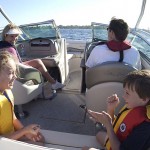 The wearing of lifejackets is the one factor that overarches most of the safety issues highlighted by this report. Indeed, it is very likely that higher lifejacket wearing rates would have prevented many of the 64.7% of recreational vessel fatalities thought to have been caused by drowning over the period 2002–03 to 2011–12.
The wearing of lifejackets is the one factor that overarches most of the safety issues highlighted by this report. Indeed, it is very likely that higher lifejacket wearing rates would have prevented many of the 64.7% of recreational vessel fatalities thought to have been caused by drowning over the period 2002–03 to 2011–12.
First and foremost, lifejackets will greatly assist non-swimmers in remaining afloat long enough to scramble back onto a stricken vessel, to reach safety or to be rescued. However, they are also a vital safety aid for people who consider themselves good swimmers – as injury, cold water or choppy conditions can make it very difficult for even good swimmers to remain afloat if suddenly forced into the water.
Lifejackets greatly help in managing the effects of ‘cold shock’ on sudden immersion in cold water – allowing the victim to regain their composure in those first minutes during which a person not wearing a lifejacket might easily drown.
In addition, lifejackets save energy, delaying the onset of hypothermia and buying a victim valuable time to be rescued or perhaps reach safety. Not wearing a lifejacket may greatly compound the consequences of an incident – especially when factors such as cold water or alcohol are also involved.
Evidence of the value of proactive lifejacket wear is particularly strong in relation to bar crossing incidents, where the annual rate of fatal incidents has fallen by more than 55% even though the annual rate of bar crossing incidents overall did not change significantly.
Other particular safety issues, such as fire and inboard petrol engines, towing, bar crossings, alcohol, small vessels and operator age highlight topics that need to be continually reinforced to the boating public in conjunction with the overarching promotion of greater lifejacket wearing rates.
NSW Roads and Maritime Services has published a wide range of materials on each of these, with the exception of operator age. This is one area that may require further educative efforts aimed at the dual problems of complacency and declining physical abilities – especially in light of an aging population and the increasing popularity of boating amongst retirees. While this report has identified a range of circumstances likely to affect recreational boating safety outcomes, such as vessel type, time of day and nature of waterway, lifejackets remain one of the most simple and effective tools for reducing boating fatalities on the State’s waterways.



